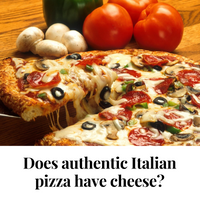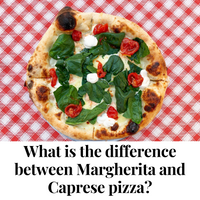
What are the main differences between a pizza stone and a pan? A pizza stone allows the pizza to bake evenly across its entire surface, eliminating extra bubbles and uneven cooking on the bottom. On the other hand, a pan will not cook the pizza evenly, and it will require 4-5 minutes more to finish cooking.
However, before diving into the culinary world of a pizza stone, there’s a lot more to know if you want to perfect your Neapolitan pizza. A pizza stone can bake homemade pizza and frozen Neapolitan pizza whenever you’re in the mood for it!
Choosing the right baking tool can make all the difference in the taste and texture of your pizza. Hence, without any further ado, let’s see the differences between pizza stone and pizza pan, perforated pizza pan, cast iron pizza pan, and much more!
What Are The Differences Between Pizza Stone Vs Pizza Pan
Below are some of the most evident differences between a pizza stone and a pizza pan. If you want to know more about the alternatives of a pizza stone, click here to learn more!
Material
For pizza, stones are usually made of cordierite, clay, or ceramic. These materials are durable but can crack or break if dropped or exposed to extreme temperatures. In addition, pizza stones need to heat up inside the oven during the preheating process.
Unlike stones, trays are typically made of metal. Most are made of steel or aluminum. Some are cast iron.
Thickness
The biggest difference between a pizza pan and a stone is the thickness. A pizza stone has many microscopic pores that absorb moisture from the dough and make a crisp crust.
The surface of a pizza pan is typically thick and doesn't have holes. Nevertheless, the surface of a metal pizza pan can retain a high amount of moisture, ensuring that the bottom isn't burned.
Porous Vs. Non Porous
A pizza stone is a circular slab of stoneware. Its surface is porous, which means it can absorb heat from a conventional oven and cook pizza similarly to a brick pizza oven.
A pizza stone allows the dough to bake evenly, which results in a crisper crust. The disadvantages of using a pizza pan include the cost and maintenance of a brick oven.
On the other hand, pizza pans aren’t porous. Hence, many times your pizza crust will remain undercooked if not regulated perfectly.
Heat Conductivity
One of the most important benefits of a pizza steel is its superior heat conductivity. Steels conduct heat better than ceramic or cordierite, making it faster to cook a pizza.
Generally speaking, a pizza steel is more expensive than a stone, so make sure to do some research before you make a purchase. You will be happy you did.
Pizza Stone Vs Pizza Pan: Who Wins?
A pizza stone is much heavier than a standard pizza pan, and it takes much longer to heat up. If you don't have a wood-fired pizza oven, you might want to invest in a pizza stone. The resulting pizza will have a flavor similar to that of a pizza baked in a fire oven. However, the benefits of a pizza stone outweigh the disadvantages.
Why You Should Invest in a Pizza Stone
If you've been putting off making your own pizza for a while, the time and money you save will be well worth it in the end. This section will help you decide whether to invest in a round or square one, and give you some tips on how to make the most of your new pizza stone.
Durability
A good pizza stone is affordable and easy to clean. A good one should be durable, and you can use it for several years. They should be preheated before using them, so you can ensure they'll last for many years.
Heating Capacity
You can heat them safely up to 300 degrees Celsius and should start by letting them warm up slowly. You should never use a pizza stone for a wood-fired barbeque, though.
Versatility
Apart from making great pizzas, you can use a pizza stone for a variety of other tasks. You can bake your favorite dishes, such as bread, on it, and also bake frozen pizzas. It is also useful for baking other foods such as vegetables and bread.
When roasted, just sprinkle with oil and season with your favorite spices. Make sure to stir frequently while cooking to avoid burning. You can use the same stone to cook frozen foods as well, as the stone absorbs ice crystals from your freezer.
How To Use A Pizza Stone

If you've recently bought a pizza stone, you may be wondering how to use it properly. After all, pizza stones can be tricky to clean. While they may not be as difficult, some basic tips and guidelines will help you avoid making mistakes. Hopefully, these will help you bake your next delicious pizza with ease!
To prepare your pizza for baking, preheat your oven and insert the pizza stone into the oven. Then, place your pizza on the oven's center shelf. It'll take around 15 minutes to cook, depending on the thickness of the crust.
Once the crust is golden brown and the cheese has melted, you're ready to remove it from the oven. Be sure to use a pizza paddle to do so, as you don't want to burn your hands. Once it's cool, remove the stone from the oven and allow it to cool before removing the pizza.
Once your pizza has baked, remove it from the oven and clean the stone thoroughly. You can use a scouring pad or plastic spatula to remove any leftover residue. After cleaning, dry the stone and let it air dry.
Lastly, it's important to remember to brush your stone with warm water after using it to avoid stains. While pizza stones absorb water from hot food, they're not impervious to soap, so make sure you brush them thoroughly after every use.
For stubborn stains, you can also use baking soda mixed with a little warm water. You should let your stone sit for several hours before using it again. This will ensure that the baking soda has thoroughly removed any caked-on food.
Pizza Stone Vs Perforated Pizza Pan
One of the first things you should know is that using a stone for your pizza will produce a crispier crust. The stone will have a large amount of thermal mass, which will help it absorb the steam from your dough while baking.
A heavy pan will also produce a better crust because it is more durable. Both stone and perforated pans will make a great crust, but there are some important differences to consider.
A pizza stone is much heavier and takes longer to heat up. Because the stone holds more heat, it is better for baking your pizza. It also gives you a nice crispy bottom crust. A pizza stone is also a little more difficult to clean than a perforated pan. A pizza stone requires a lot of care to use. And since it is heavier, it is recommended to use it with care.
If you are a beginner, a pizza pan is a great choice. Both are cheap and easy to use. The main differences between a stone and a perforated pizza pan are the cooking surface and the amount of heat. Using a stone will produce a crisper crust and a lighter, airier dough. A stone is closer to the Neapolitan oven in terms of temperature.
The perforated pan has uniform holes that allow the heat to reach the entire pizza. You can use it in the oven without a problem, but be sure to monitor it carefully. Excess moisture can lead to uneven cooking, burning, soggy centers, and uneven cooking.
If you’re confused between aluminum and steel pizza pans, click here to know more.
A perforated pan is the best choice for thin-crust pizzas, but a perforated pan can also make thick-crust pizzas less chewy. It also retains the original flavor of a pizza and helps the base bake more quickly.
Pizza Stone Vs Cast Iron Pizza Pan
When comparing the types of pans, one thing you need to know about both is that a stone will evenly cook baked goods better than a cast iron pan. Most pans are made of aluminum or thin steel, which conducts heat poorly and easily transfers it into the food.
However, a cast iron pizza pan is better than a pizza stone for two primary reasons: it retains heat well, and it's virtually indestructible. You can use your stone immediately, or you can season it first for a non-stick surface.
If you're making thin-crust pizzas, you can use a steel pizza pan, but the cast iron option will produce a crispy crust that doesn't require any kind of delicate treatment. If you’re confused about the pizza toppings that will go perfectly in your oven, click here.
Also, it will take less time to cook than the other. With the stone, you can choose the right cooking method, as they are different in many ways.
Conclusion
Once you know how to use a pizza stone properly, you can use it for years to come. Besides, it's easy to use! If you're a first-time pizza maker, a stone is a great alternative to a pizza oven, and can make your Neapolitan pizzas bake to perfection. A good pizza stone will do justice to your delicious frozen pizza, so don’t forget to try it out!
Our real Italian pizzas from Italy are handmade with all-natural of high quality and fresh ingredients in Naples, Italy delivered to you, anywhere in the U.S. Free Shipping Nationwide. Buy now here!









0 comments